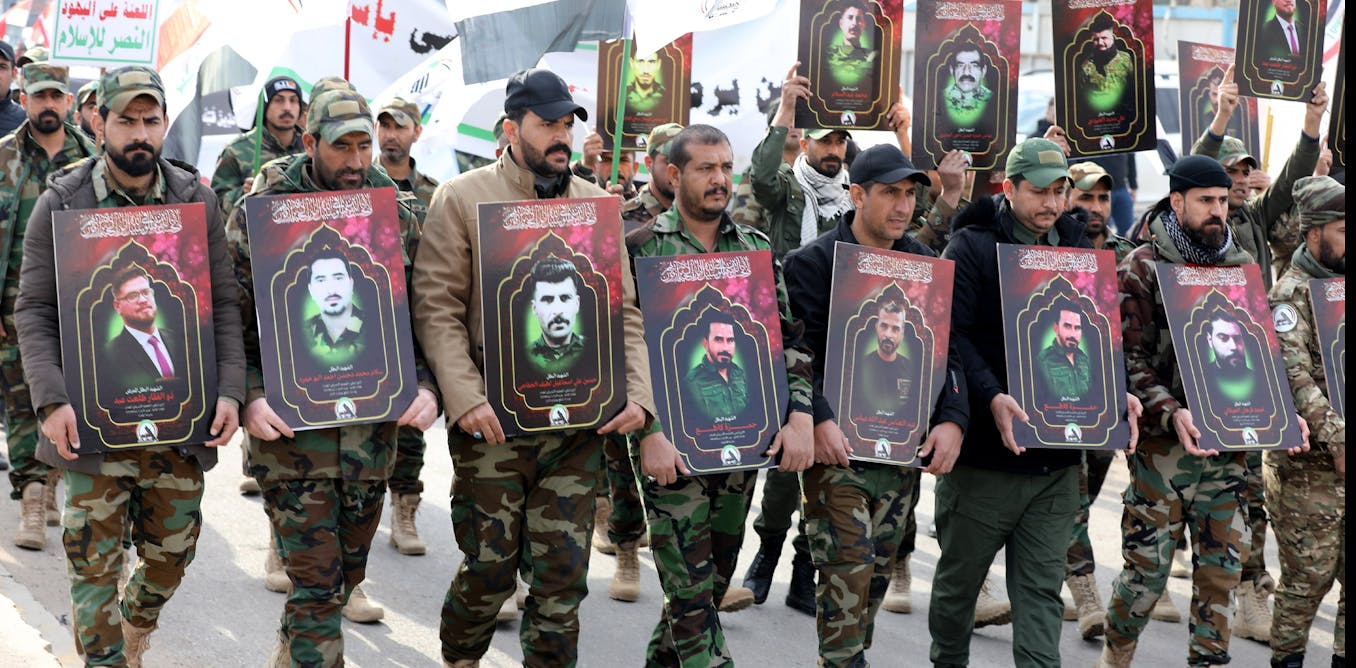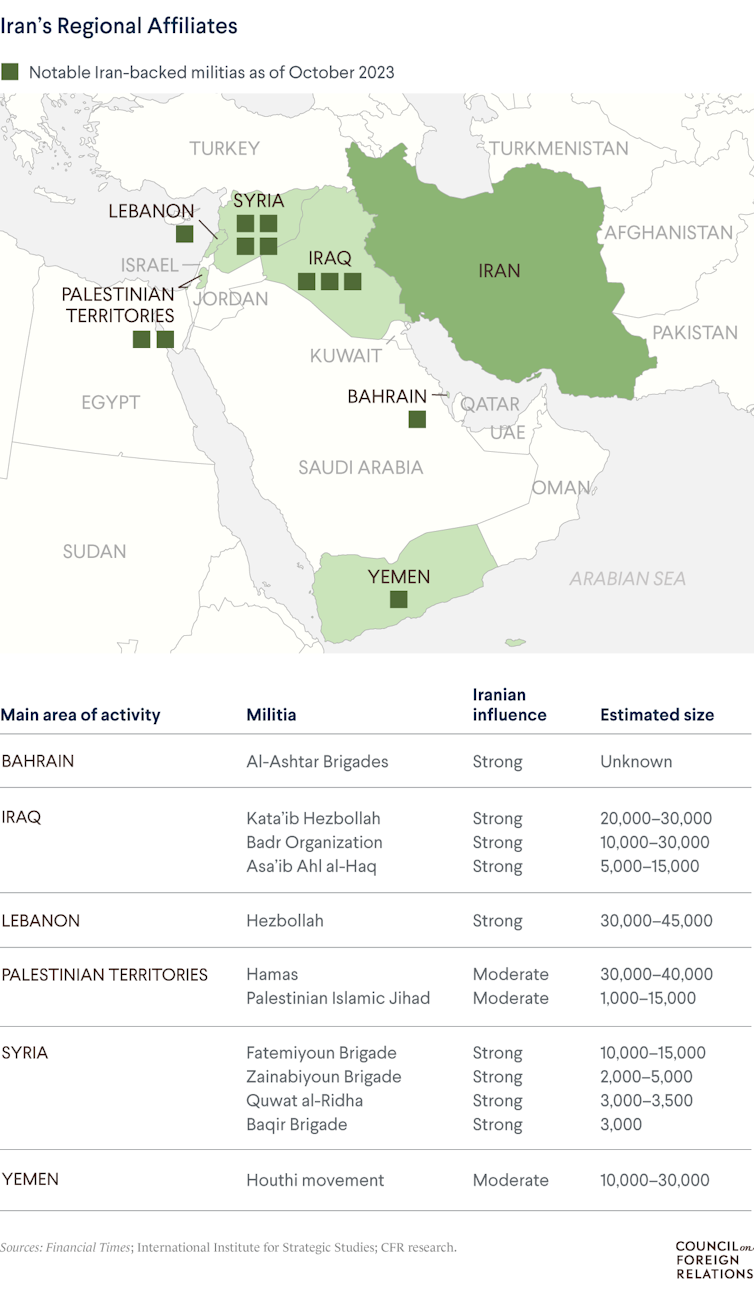You are using an out of date browser. It may not display this or other websites correctly.
You should upgrade or use an alternative browser.
You should upgrade or use an alternative browser.
US Navy patrolling the Arabian Gulf and Red Sea against Iran 🇮🇷 /Houthis’ 🇾🇪 Thread
- Thread starter ☑︎#VoteDemocrat
- Start date
More options
Who Replied?ADevilYouKhow
Rhyme Reason
Sent him to spirit realm


That R9X is nastySent him to spirit realm



How Iran controls a network of armed groups to pursue its regional strategy
Iran funds a large network of armed groups across the Middle East as part of its ambition to replace the US as regional power.
 theconversation.com
theconversation.com

ADevilYouKhow
Rhyme Reason
B-1B supersonic bombers sent a 'powerful' message to Iran's proxies all the way from Texas
A former US Air Force colonel said the B-1B Lancer was the ideal aircraft to retaliate against Iran-backed groups in Iraq and Syria.
ADevilYouKhow
Rhyme Reason
Houthis strike Iran-bound grain ship in first Red Sea attack in six days — Guardian US
Militants fired missiles at Greek-owned ship, says US military, in strike that raises questions over who Houthis are trying to target
Strike Iran bound grain ships Houthi terrorist Brehs

ADevilYouKhow
Rhyme Reason
#FreeYemen

Israel Was Behind Attacks on Major Gas Pipelines in Iran, Officials Say (Published 2024)
The sabotage, which analysts said marked an escalation in the shadow war between Israel and Iran, caused sweeping disruption in several provinces.
Israel Was Behind Attacks on Major Gas Pipelines in Iran, Officials Say
The sabotage, which analysts said marked an escalation in the shadow war between Israel and Iran, caused sweeping disruption in several provinces.
Feb. 16, 2024Updated 5:23 p.m. ET
Two people standing looking at flames from an explosion.
The sabotage targeted several points along two of Iran’s main natural gas pipelines. At the site of one attack, in Chahar Mahal Bakhtiari, two people stared at flames from the explosion. Reza Kamali Dehkordi/Fars News Agency, via Associated Press
Sign up for the Israel-Hamas War Briefing. The latest news about the conflict.
Israel carried out covert attacks on two major natural gas pipelines inside Iran this week, disrupting the flow of heat and cooking gas to provinces with millions of people, according to two Western officials and a military strategist affiliated with Iran’s Revolutionary Guards Corps.
The strikes represent a notable shift in the shadow war that Israel and Iran have been waging by air, land, sea and cyberattack for years.
Israel has long targeted military and nuclear sites inside Iran — and assassinated Iranian nuclear scientists and commanders, both inside and outside of the country. Israel has also waged cyberattacks to disable servers belonging to the oil ministry, causing turmoil at gas stations nationwide.
But blowing up part of the country’s energy infrastructure, relied on by industries, factories and millions of civilians, marked an escalation in the covert war and appeared to open a new frontier, officials and analysts said.
“The enemy’s plan was to completely disrupt the flow of gas in winter to several main cities and provinces in our country,” Iran’s oil minister, Javad Owji, told Iranian media on Friday.
Mr. Owji, who had previously referred to the blasts as “sabotage and terrorist attacks,” stopped short of publicly blaming Israel or any other culprit. But he said that the goal of the attack was to damage Iran’s energy infrastructure and stir domestic discontent.
Iran’s Minister of Petroleum Eng Javad Owji arriving at the 8th OPEC International Seminar in Vienna, Austria, in July.Alex Halada/Agence France-Presse — Getty Images
The office of Israel’s Prime Minister Benjamin Netanyahu declined to comment.
The Western officials and the Iranian military strategist said the gas pipeline attacks by Israel required deep knowledge of Iran’s infrastructure and careful coordination, especially since two pipelines were hit in multiple locations at the same time.
One Western official called it a major symbolic strike that was fairly easy for Iran to repair and caused relatively little harm to civilians. But, the official said, it sent a stark warning of the damage that Israel could inflict, as conflict spreads across the Middle East and tensions rise between Iran and its adversaries, notably Israel and the United States.
The Western officials said Israel also caused a separate blast on Thursday inside a chemical factory on the outskirts of Tehran that rattled a neighborhood and sent plumes of smoke and fire into the air. But local officials said the factory explosion, which took place on Thursday, stemmed from an accident in the factory’s fuel tank.
Iran has said that it does not want a direct war with the United States, and it has denied being involved in either the Oct. 7 terrorist attacks against Israel or the various attacks against American and Israeli targets in the region since then.
But Iran supports and arms a network of proxy militia that have been actively fighting with Israel and United States, including the Houthis in Yemen, Hezbollah in Lebanon and militants in Iraq and Syria. Iran has also armed and trained Hamas and other Palestinian fighters.
The strikes and counter-strikes across the region have escalated in recent months. Israel has killed two senior Iranian commanders in Syria, while the United States has struck military bases connected to the Revolutionary Guards and its proxies in Iraq and Syria after three American soldiers were killed in a drone attack.
Iran also suffered one of the largest terrorist attacks in its history in January, when suicide bombers killed about 100 people in Kerman during a ceremony for a top general, Qassim Suleimani, killed by the United States four years ago. ISIS claimed responsibility for the suicide attack.
A crowd of mourners fathered around flag-draped coffins.
Mourners in Tehran carried the flag-draped coffins of Iranian Revolutionary Guard members killed in an Israeli airstrike in Syria in January. Arash Khamooshi for The New York Times
Now, the Western officials say, Israel has attacked inside Iran’s borders with back-to-back explosions that have unnerved Iranians.
“This shows that the covert networks operating in Iran have expanded their target list and advanced beyond just military and nuclear sites,” said Shahin Modarres, a Rome-based security analyst focused on the Middle East. “It’s a major challenge and reputation blow for Iran’s intelligence and security agencies.”
The sabotage targeted several points along two main gas pipelines in the provinces of Fars and Chahar Mahal Bakhtiari on Wednesday. But the disruption in service stretched to residential homes, government buildings and major factories in at least five provinces across Iran, according to Iranian officials and local media reports.
The pipelines carry gas from the south to major cities like Tehran and Isfahan. One of the pipelines runs all the way to Astara, a city near Iran’s northern border with Azerbaijan.
Energy experts estimated that the attacks on the pipelines, which each run for about 1,200 kilometers or 800 miles and carry 2 billion cubic feet of natural gas per day, knocked out about 15 percent of Iran’s daily natural gas production, making them particularly sweeping assaults on the country’s critical infrastructure.
“The level of impact was very high because these are two significant pipelines going south to north,” said Homayoun Falakshahi, a senior energy analyst at Kpler. “We have never seen anything like this in scale and scope.”
On Friday, Mr. Owji, the oil minister, said that technical teams from the ministry had worked around the clock to repair the damage, and that the disruption had been minimal and service restored.
But his assessment was at odds with the comments of local governors and officials from Iran’s national gas company, who had described widespread outages of service in five provinces, forcing the closure of government buildings. On social media, Iranian energy experts advised people in the affected areas, where in some places temperatures dropped below freezing, to dress warmly.
The blasts happened at around 1 a.m. local time, terrifying residents, who fled their homes and poured into the streets, according to Iranian media reports. On social media, people described blasts so loud that they woke up thinking a bomb had been dropped. No casualties were reported.
A giant Iranian flag and missiles pointing upward at a celebration marking the 45th anniversary of the Islamic revolution.
Missiles and a giant flag in Tehran marking the 45th anniversary of the Islamic revolution on Sunday. Attacks on two of Iran’s major gas pipelines Wednesday were a notable shift in the shadow war long waged by Iran and Israel, analysts said. Arash Khamooshi for The New York Times
Saeid Aghli, an official with the national gas company, told Iranian media that officials immediately called an emergency meeting attended by the oil minister, officials from the foreign ministry and representatives from all of Iran’s intelligence and security services. Mr. Aghli said the sabotage was intended to take out about 40 percent of the country’s gas transmission capacity.
How the pipelines were struck — with drones, explosives attached to pipes or some other means — remains unclear. Iran’s energy infrastructure has been targeted in the past, but those incidents were much smaller in scope and scale, analysts said.
The military strategist affiliated with the Revolutionary Guards Corps — who, like the other officials, was not authorized to speak publicly — said the Iranian government believed Israel was behind the attack because of the complexity and scope of the operation. The attack, he said, almost certainly required the help of collaborators inside Iran to figure out where and how to strike.
He noted that major pipelines in Iran, which carry gas across vast distances that include mountains, deserts and rural fields, are patrolled by guards in outposts along the length of the pipes. The guards check their areas every few hours, he said, so the attackers may have had knowledge of their breaks, when the area would remain unmanned.
Mr. Falakshahi, the energy analyst, said the blasts exposed the vulnerability of the country’s critical infrastructure to attacks and sabotage. He said that Iran, the third largest producer of natural gas in the world, has about 40,000 kilometers of natural gas pipelines, mostly underground. He added that the pipelines are primarily for domestic consumption and that, because of sanctions, Iran’s export of gas was minimal and limited to Turkey and Iraq.
“It’s very difficult to protect this very extensive network of pipelines unless you invest billions in new technology,” Mr. Falakshahi said. He added that repairing the damaged pipelines would require shutting off the gas and then replacing the pipes, which could take days.
Farnaz Fassihi is a reporter for The New York Times based in New York. Previously she was a senior writer and war correspondent for the Wall Street Journal for 17 years based in the Middle East. More about Farnaz Fassihi
Ronen Bergman is a staff writer for The New York Times Magazine, based in Tel Aviv. His latest book is “Rise and Kill First: The Secret History of Israel’s Targeted Assassinations,” published by Random House. More about Ronen Bergman
A version of this article appears in print on Feb. 17, 2024, Section A, Page 9 of the New York edition with the headline: Israel Was Behind Iran Attacks, Officials Say. Order Reprints | Today’s Paper | Subscribe
